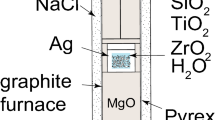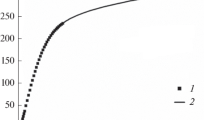Abstract
A method is described for estimating the activity of titania (TiO2) in a magmatic liquid from the compositions of coexisting cubic oxide (spinel) and rhombohedral oxide (ilmenite). These estimates are derived from the thermodynamic models of Ghiorso and Evans (Am J Sci 308:957–1039, 2008; see also Sack and Ghiorso in Contrib Mineral Petrol 106:474–505, 1991a; Am Mineral 76:827-847, 1991b) and may be computed self consistently along with temperature and oxygen fugacity for an assumed pressure. The method is applied to a collection of 729 naturally occurring oxide pairs from rhyolites and dacites. For this suite of oxides, values of titania activity relative to rutile saturation range from 0.3 to 0.9. Genetically related groups of oxide pairs display activity–temperature trends with negative slopes at higher activities (0.6–0.9) or positive slopes at lower activities (0.3–0.7). Thermodynamic analysis supports the assumption of two-oxide, liquid equilibrium for the former group, but suggests that such an interpretation for oxide sequences with positive activity–temperature trends may be problematic. Application of the estimation method to oxide pairs from the Shiveluch Volcano and the Bishop Tuff reveals that the former are consistent with having equilibrated with known matrix glass compositions, whereas the latter pairs are inconsistent with equilibration with pre-eruptive liquids trapped in quartz inclusions.




Similar content being viewed by others
References
Anderson AT, Davis AM, Lu FQ (2000) Evolution of Bishop Tuff rhyolitic magma based on melt and magnetite inclusions and zoned phenocrysts. J Petrol 41:449–473
Berman RG (1988) Internally-consistent thermodynamic data for minerals in the system Na2O-K2O-CaO-MgO-FeO-Fe2O3-Al2O3-SiO2-TiO2-H2O-CO2. J Petrol 29:445–522
Buddington AF (1956) Thermometric and petrogenetic significance of titaniferous magnetite—reply. Am J Sci 254:511–515
Buddington AF, Lindsley DH (1964) Iron-titanium oxide minerals and synthetic equivalents. J Petrol 5:310–357
Buddington AF, Fahey J, Vlisdis A (1955) Thermometric and petrogenetic significance of titaniferous magnetite. Am J Sci 253:497–532
Dirksen O, Humphreys MCS, Pletchov P, Melnik O, Demyanchuk Y, Sparks RSJ, Mahony S (2006) The 2001–2004 dome-forming eruption of Shiveluch volcano, Kamchatka: observation, petrological investigation and numerical modelling. J Volcanol Geotherm Res 155:201–226
Ferry JM, Watson EB (2007) New thermodynamic models and revised calibrations for the Ti-in-zircon and Zr-in-rutile thermometers. Contrib Mineral Petrol 154:429–437
Ghiorso MS, Evans W (2008) Thermodynamics of Rhombohedral Oxide Solid Solutions and a Revision of the Fe–Ti Two-oxide geothermometer and oxygen-barometer. Am J Sci 308:957–1039
Ghiorso MS, Sack RO (1995) Chemical mass transfer in magmatic processes IV. A revised and internally consistent thermodynamic model for the interpolation and extrapolation of liquid-solid equilibria in magmatic systems at elevated temperatures and pressures. Contrib Mineral Petrol 119:197–212
Gualda GAR, Rivers M (2006) Quantitative 3D petrography using x-ray tomography: application to Bishop Tuff pumice clasts. J Volcanol Geotherm Res 154:48–62
Gualda GAR, Ghiorso MS, Lemons RV, Carley TL (2012) Rhyolite-MELTS: a modified calibration of MELTS optimized for silica-rich, fluid-bearing magmatic systems. J Petrol 53:875–890
Hayden LA, Watson EB, Wark DA (2008) A thermobarometer for sphene (titanite). Contrib Mineral Petrol 155:529–540
Hildreth W (1977) The magma chamber of the Bishop Tuff: gradients in temperature, pressure, and composition. Dissertation, University of California at Berkeley, pp 328
Hildreth W (1979) The Bishop Tuff: evidence for the origin of compositional zonation in silicic magma chambers. Geol Soc Am Special Pap 180:43–75
Hildreth W, Wilson CJN (2007) Compositional zoning of the Bishop Tuff. J Petrol 48:951–999
Humphreys MCS, Blundy JD, Sparks RSJ (2008) Shallow-level decompression crystallisation and deep magma supply at Shiveluch Volcano. Contrib Mineral Petrol 155:45–61
O’Neill HStC, Pownceby ML (1993) Thermodynamic data from redox reactions at high temperatures. I. An experimental and theoretical assessment of the electro-chemical method using stabilized zirconia electrolytes, with revised values for the Fe-“FeO”, Co-CoO, Ni-NiO, and Cu-Cu2O oxygen buffers, and new data for the W-WO2 buffer. Contrib Mineral Petrol 114:296–314
Reid MR, Vazquez JA, Schmitt AK (2011) Zircon-scale insights into the history of a Supervolcano, Bishop Tuff, Long Valley, California, with implications for the Ti-in-zircon geothermometer. Contrib Mineral Petrol 161:293–311
Sack RO, Ghiorso MS (1991a) An internally consistent model for the thermodynamic properties of Fe-Mg-titanomagnetite-aluminate spinels. Contrib Mineral Petrol 106:474–505
Sack RO, Ghiorso MS (1991b) Chromian spinels as petrogenetic indicators: thermodynamics and petrological applications. Am Mineral 76:827–847
Thomas JB, Watson EB, Spear FS, Shemella PT, Nayak SK, Lanzirotti A (2010) TitaniQ under pressure: the effect of pressure and temperature on the solubility of Ti in quartz. Contrib Mineral Petrol 160:743–759
Verhoogen J (1962) Oxidation of iron-titanium oxides in igneous rocks. J Geol 70:168–181
Wallace PJ, Anderson AT Jr, Davis AM (1995) Quantification of pre-eruptive exsolved gas contents in silicic magmas. Nature 377:612–616
Wallace PJ, Anderson AT Jr, Davis AM (1999) Gradients in H2O, CO2, and exsolved gas in a large-volume silicic magma system: interpreting the record preserved in melt inclusions from the Bishop Tuff. J Geophys Res 104:20097–20122
Wark DA, Watson EB (2006) TitaniQ: a titanium-in-quartz geothermometer. Contrib Mineral Petrol 152:743–754
Wark DA, Hildreth W, Spear FS, Cherniak DJ, Watson EB (2007) Pre-eruption recharge of the Bishop Magma system. Geology 35:235–238
Acknowledgments
We would like to thank Colin Wilson for originally suggesting the idea that the activity of titania might be estimated from oxide pairs and to Calvin Miller who suggested that thermodynamic reasoning might be applied to the patterns of activity–temperature relations exhibited by volcanic rock sequences. Jay Thomas and Jon Blundy provided constructive and insightful reviews. Material support for this contribution was provided by the National Science Foundation (EAR 09-48734 to MSG, and EAR 09-48528 to GARG).
Author information
Authors and Affiliations
Corresponding author
Additional information
Communicated by T. Grove.
Rights and permissions
About this article
Cite this article
Ghiorso, M.S., Gualda, G.A.R. A method for estimating the activity of titania in magmatic liquids from the compositions of coexisting rhombohedral and cubic iron–titanium oxides. Contrib Mineral Petrol 165, 73–81 (2013). https://doi.org/10.1007/s00410-012-0792-y
Received:
Accepted:
Published:
Issue Date:
DOI: https://doi.org/10.1007/s00410-012-0792-y




